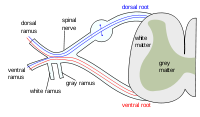
Photo from wikipedia
Personality traits such as impulsivity or sensitivity to rewards and punishments have been associated with risky driving behavior, but it is still unclear how brain anatomy is related to these… Click to show full abstract
Personality traits such as impulsivity or sensitivity to rewards and punishments have been associated with risky driving behavior, but it is still unclear how brain anatomy is related to these traits as a function of risky driving. In the present study, we explore the neuroanatomical basis of risky driving behavior and how the level of risk-taking influences the relationship between the traits of impulsivity and sensitivity to rewards and punishments and brain gray matter volume. One hundred forty-four participants with different risk-taking tendencies assessed by real-life driving situations underwent MRI. Personality traits were assessed with self-report measures. We observed that the total gray matter volume varied as a function of risky driving tendencies, with higher risk individuals showing lower gray matter volumes. Similar results were found for volumes of brain areas involved in the reward and cognitive control networks, such as the frontotemporal, parietal, limbic, and cerebellar cortices. We have also shown that sensitivity to reward and punishment and impulsivity are differentially related to gray matter volumes as a function of risky driving tendencies. Highly risky individuals show lower absolute correlations with gray matter volumes than less risk-prone individuals. Taken together, our results show that risky drivers differ in the brain structure of the areas involved in reward processing, cognitive control, and behavioral modulation, which may lead to dysfunctional decision-making and riskier driving behavior.
Journal Title: Behavioural Neurology
Year Published: 2022
Link to full text (if available)
Share on Social Media: Sign Up to like & get
recommendations!